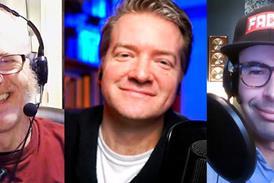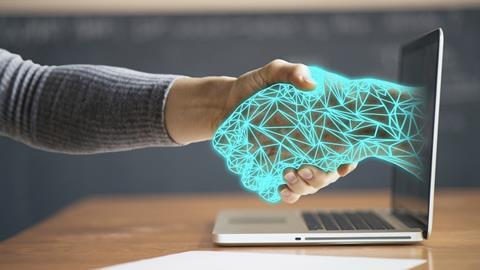Apologists Clinton Wilcox and Joel Furches explore some of the core principles of transhumanism and their ramifications
“We are the Borg. Lower your shields and surrender your ships. We will add your biological and technological distinctiveness to our own. Your culture will adapt to service us. Resistance is futile.”
So comes the welcoming speech given by one of television’s greatest villains: the Borg of the Star Trek franchise. These fictional creatures are a cybernetic species who don’t procreate naturally, but instead propagate by way of capturing humanoids and fitting them with cybernetic parts. These individuals are then plugged into a network and mentally enslaved to their alien captors.
Read more:
ChatGPT, AI and the future - living faithfully in a technologically confusing world
AI won’t overthrow humanity but it could radically undermine it
Should Christians be Concerned about the Rapid Advancements in Artificial Intelligence?
How do we build robots that know right from wrong?
What does Christianity have to say about ‘big tech’?
When asked, the queen of the Borg said that her race travels from star system to star system forcing people into their collective against their will as a benefit to those people. The goal of the Borg is nothing short of total perfection. Bringing others into their collective helps the captured people to attain the perfection they are seeking.
The writers of Star Trek were unaware they were pre-figuring the transhumanism movement, only a few decades away. This modern-day equivalent of the Borg ideal also seeks to achieve perfection through fusing humanity with machine enhancements. The purposes of these enhancements include extension of life span, elimination of pain and suffering, and increase in physical and mental capabilities. This would theoretically usher in the next stage of human evolution: a posthuman utopia.
Of course, to the transhumanist, Darwinian evolution would have happened naturally, through random processes. But humans have reached a state of intelligence sufficient to direct and control their own evolution and improve themselves through the use of technology. Evolution, says the transhumanist, is obsolete.
Fazale Rana and Kenneth Samples point out that transhumanism has no official founder, “…but some transhumanist authors claim to see its broad distinctives connected to ideas reflected in the history of western thought” (Fazale R Rana and Kenneth R Samples, ‘Humans 2.0: Scientific, Philosophical, and Theological Perspectives on Transhumanism’).
Transhumanism and ‘selfhood’
Transhumanism is a common theme in science fiction, and writers have generally portrayed it as a threat. The aforementioned Borg roam the universe, forcing people into their collective. But the heroes of Star Trek will oppose them, even if it means losing their lives, because becoming Borg is a fate worse than death - those connected to the collective lose their free will and their sense of self. In short, they cease to be truly human after the assimilation. Not unlike its science fiction counterpart, transhumanism raises several interesting questions about personal identity.
The means already exist to artificially enhance strength, concentration and alertness by way of drugs and hormones. One might also artificially alter the way one appears to others by means of surgery, which reduces the appearance of ageing so that one will consider oneself more attractive, or achieve the social benefits associated with a youthful appearance. These kinds of processes have existed and been exercised for years. However, as technology advances, the theoretical possibility of genetic modification and electronic enhancements to intelligence are becoming a subject of discussion in academic circles. Whereas the ethics of self-enhancement by way of artificial means are one debate, the effects of such enhancements on the ‘self’ constitute another question.
Whereas it may not be possible to conduct a study on the effects of genetic engineering on self-conception, studies have been done on steroid use in bodybuilders and self-image. These studies indicate that bodybuilders are motivated to use steroids because they want to achieve an enhanced self, and steroid use was an artificial means of doing so.
But unlike natural means to self-enhancement, such as regular exercise, steroid use had mixed results. Some bodybuilders who used steroids as a method to increase muscle mass increased their self-image, but others suffered from reduction of self-esteem, body dysmorphia and similar problems. This may have some relationship to the so-called ‘imposter syndrome’, wherein the individual may recognize that the social regard his or her new appearance allows is the result of artificial means rather than personal accomplishment.
A similar study on cosmetic surgery yielded similar results, with the exception that the surgery did not significantly alter the individual’s self-esteem or self-image before and after. Meaning that self-image neither improved nor declined, making the artificial enhancement inconsequential to the idea of ‘self’.
This data may be a strong indication of what one might see in a future when genetic engineering and technology are available to modify oneself in appearance or in abilities. If the existing studies are consistent with future developments in self-enhancement, these artificial enhancements are less effective at improving self-image than natural means such as study, exercise or hard work.
Get access to exclusive bonus content & updates: register & sign up to the Premier Unbelievable? newsletter!
Transhumanism and suffering
No one likes to suffer. Suffering does have its purpose in life but it’s not fun to go through. Some have even argued that because pain is such a part of life, bringing new people into the world is a harm to those people (David Benatar is a well-known example of this, arguing that existence is such a harm that we have a moral obligation to refrain from reproducing).
The primary promise underlying transhumanism is that pain will be eliminated, that we can defeat death by extending our life spans, and transhumanism offers salvation from the pain and death we all have in our futures. Of course, Christians believe in an omnipotent, omnibenevolent God who not only created us but has given us the scriptures. On this view, the Christian knows that salvation is only found in Christ Jesus. Jesus conquered death when he came to the cross and rose again on the third day. He endured immense suffering, both emotional and physical, in his path to the cross. Christ knows what it is to suffer and is not blind or unfeeling to the suffering we endure as human beings.
As Christians, we place our faith in God not in technology. This is not to pit God against technology as if the two were incompatible or in opposition to one another. Rather, it is to put each in its proper place. Anyone who has ever owned a laptop or a car knows technology fails. But God is faithful to keep his promises.
God has promised us our sufferings will last only a little while compared to the eternity we have to look forward to in a place where there is no more pain or suffering (2 Cor 4:17, Rom 8:18, James 1:2-4). We have also been assured that our suffering has a purpose (Rom 5:3-5) and God works everything for the good of those who love him (Rom 8:28).
Technology that eliminates suffering sounds good in theory because of how unpleasant it is to suffer, but considering everything suffering produces in us - things like endurance and character - eliminating suffering would have the effect of making us less compassionate toward other people, among other things. So, according to scripture, while pain is unpleasant it has actual benefits to us as human beings.
But what about death?
Transhumanism and death
Death is the ultimate harm that can ever be done to someone in this world. It takes away everything from that person in this world, prevents him or her from being able to fulfil future plans and removes a unique individual with a lifetime of experiences, thoughts and emotions from existence.
Of course, some religions teach there is a life after our time here on Earth is finished and that serves as a great comfort to followers of those religions. But if you are an atheist or agnostic, you would obviously deny such an ‘afterlife’ exists, so it makes sense, if you want to avoid death, that you will go to great pains to extend your life and avoid your death for as long as you can.
The primary solution to death discussed in transhumanist circles is the uploading of one’s thoughts and memories to a computer system such that those thoughts and memories would continue after the body is dead. This is, however, something like preserving a fingerprint without the finger which supplied it.
Even assuming that one’s ‘selfhood’ is the product of thoughts and memories stored in the brain, the idea that a digital replication of those thoughts and memories is the same as you is more like the product of wishful thinking than anything one can support concretely. Yet when one does not allow for a soulical element to human nature, this is the closest thing to an afterlife one can imagine. It is also worth noting that the technology to do this does not yet exist, and whether it can ever be developed is a matter of speculation.
In Christianity, we believe in a God who understands our fears and has the power to overcome the grave. He went to the cross, dying the death we deserved and then rose again to show us that he has this power. As Christians, we don’t have to fear death because we have the confidence that God has a better place for us waiting after we leave this world.
God created this world and called it “good”, but the current world is temporary, and must perish in order for a better world to take its place. The technological advancements transhumanists are searching for will extend their stay here, perhaps indefinitely if such a thing would ever be possible. But we were never meant to stay here indefinitely. The Christian schema offers not just the body of a cyborg or a brain in a digital vat, but rather a new and incorruptible body in a new and incorruptible world.
Conclusion
So, we have seen that transhumanism looks to solve problems such as self-improvement, pain and death through technological means. Evidence suggests that when self-improvement is done through artificial means rather than hard work, it does not result in the individual feeling better about him or herself, and can often injure one’s self-image.
Similarly, the presence of pain in life, although unpleasant, creates an avenue of struggle which may lead to self-improvement. Finally, in the Christian worldview, the problem of death has already been dealt with, and the promise given is resurrection in an incorruptible body to an eternal life. Technology need not apply.
Transhumanism is an understandable philosophy from people who have no hope of a life free of pain and suffering after our time in this world is over. But transhumanism offers a false salvation that may bring with it unintended and unanticipated harms. In Christ, we have true salvation offered by the one who created us, who created the universe and who has the ultimate power over death itself. God has promised us a better life after we are finished here. What a wonderful thing to believe in and hope for.
Clinton Wilcox is a staff apologist for Life Training Institute. He specializes in training pro-life people to make the pro-life case more effectively and persuasively. He is also a certified speaker and mentor for Justice for All. You can read his blog and follow him on Twitter.
Joel Furches is an apologist, journalist and researcher on conversion and deconversion, based in the USA.























